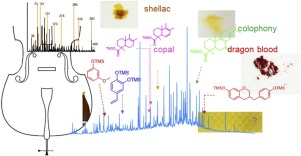当前位置:
X-MOL 学术
›
J. Anal. Appl. Pyrol.
›
论文详情
Our official English website, www.x-mol.net, welcomes your feedback! (Note: you will need to create a separate account there.)
Identification of organic materials in historic stringed instruments by off-line analytical pyrolysis solid-phase microextraction with on-fiber silylation and gas chromatography-mass spectrometry
Journal of Analytical and Applied Pyrolysis ( IF 6 ) Pub Date : 2020-01-01 , DOI: 10.1016/j.jaap.2019.104727 Lisa Kasprzok , Daniele Fabbri , Alessandro G. Rombolà , Tommaso Rovetta , Marco Malagodi
Journal of Analytical and Applied Pyrolysis ( IF 6 ) Pub Date : 2020-01-01 , DOI: 10.1016/j.jaap.2019.104727 Lisa Kasprzok , Daniele Fabbri , Alessandro G. Rombolà , Tommaso Rovetta , Marco Malagodi

|
Abstract Historical stringed musical instruments are a unique class of cultural heritage objects. Crafted during the 16th-18th centuries, these instruments remain somewhat mysterious. Due to the absence of written historical documents of traditional varnish recipes, their chemical characterization is the only way to recover the lost ‘secret’ of the Cremonese stringed instrument maker Antonio Stradivari and his contemporaries, whose traditions had been lost by 1800. Pyrolysis combined with gas chromatography-mass spectrometry (GC–MS) using solid-phase microextraction (SPME) followed by on-fiber silylation (Py SPME Syl GC–MS) was applied to a large collection of standards to evaluate its validity for compositional analysis and material identification of historical stringed instrument varnishes. The standards included pure resins (colophony, amber, mastic, sandarac, elemi), different types of shellac, as well as colorants or additives such as madder, dragon’s blood, and Aloe vera powder, and other materials (propolis, beeswax). The aim was to obtain an extensive collection of GC–MS data of silylated pyrolysis products useful for the characterization of the finishes of these unique historical objects. A set of distinct pyrolysis patterns and products were chosen as specific molecular markers for each standard. The method was applied to instrument varnish samples from Stainer, Baioni, Amati, Guarneri, Gasparo da Salo, Maggini, and Guadagnini instruments. The method was shown to be effective for the identification of oxidized lignin, drying oils, and diterpenic resins. In the case of dragon’s blood, madder, shellac, and propolis new markers were identified, suggesting their presence in some instrument varnishes. The identification of proteins and madder appeared most challenging.
中文翻译:

通过离线分析热解固相微萃取与纤维硅烷化和气相色谱-质谱法鉴定历史弦乐器中的有机材料
摘要 历史上的弦乐器是一类独特的文化遗产。这些乐器制作于 16 至 18 世纪,至今仍有些神秘。由于缺乏传统清漆配方的书面历史文件,他们的化学特性是恢复克雷蒙弦乐器制造商安东尼奥·斯特拉迪瓦里及其同时代人失去的“秘密”的唯一方法,他们的传统在 1800 年已经失传。热解结合气相色谱-质谱联用 (GC-MS) 使用固相微萃取 (SPME) 和纤维上硅烷化 (Py SPME Syl GC-MS) 应用于大量标准品,以评估其成分分析和材料鉴定的有效性历史弦乐器清漆。标准品包括纯树脂(松香、琥珀、乳香、檀香、榄香)、不同类型的虫胶,以及茜草、龙血和芦荟粉等着色剂或添加剂,以及其他材料(蜂胶、蜂蜡)。目的是获得广泛收集的硅烷化热解产物的 GC-MS 数据,可用于表征这些独特历史物体的饰面。选择一组不同的热解模式和产物作为每个标准的特定分子标记。该方法应用于来自 Stainer、Baioni、Amati、Guarneri、Gasparo da Salo、Maggini 和 Guadagnini 仪器的仪器清漆样品。该方法被证明可有效识别氧化木质素、干性油和二萜树脂。在龙血、茜草、虫胶和蜂胶的情况下,发现了新的标记物,表明它们存在于某些乐器清漆中。蛋白质和茜草的鉴定似乎最具挑战性。
更新日期:2020-01-01
中文翻译:

通过离线分析热解固相微萃取与纤维硅烷化和气相色谱-质谱法鉴定历史弦乐器中的有机材料
摘要 历史上的弦乐器是一类独特的文化遗产。这些乐器制作于 16 至 18 世纪,至今仍有些神秘。由于缺乏传统清漆配方的书面历史文件,他们的化学特性是恢复克雷蒙弦乐器制造商安东尼奥·斯特拉迪瓦里及其同时代人失去的“秘密”的唯一方法,他们的传统在 1800 年已经失传。热解结合气相色谱-质谱联用 (GC-MS) 使用固相微萃取 (SPME) 和纤维上硅烷化 (Py SPME Syl GC-MS) 应用于大量标准品,以评估其成分分析和材料鉴定的有效性历史弦乐器清漆。标准品包括纯树脂(松香、琥珀、乳香、檀香、榄香)、不同类型的虫胶,以及茜草、龙血和芦荟粉等着色剂或添加剂,以及其他材料(蜂胶、蜂蜡)。目的是获得广泛收集的硅烷化热解产物的 GC-MS 数据,可用于表征这些独特历史物体的饰面。选择一组不同的热解模式和产物作为每个标准的特定分子标记。该方法应用于来自 Stainer、Baioni、Amati、Guarneri、Gasparo da Salo、Maggini 和 Guadagnini 仪器的仪器清漆样品。该方法被证明可有效识别氧化木质素、干性油和二萜树脂。在龙血、茜草、虫胶和蜂胶的情况下,发现了新的标记物,表明它们存在于某些乐器清漆中。蛋白质和茜草的鉴定似乎最具挑战性。



























 京公网安备 11010802027423号
京公网安备 11010802027423号